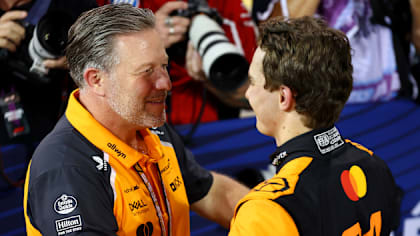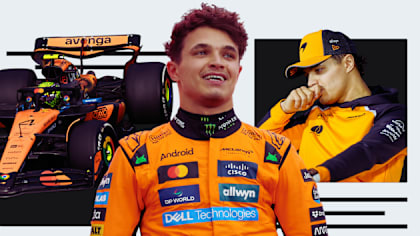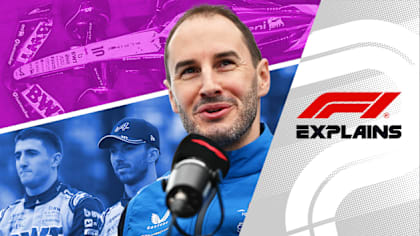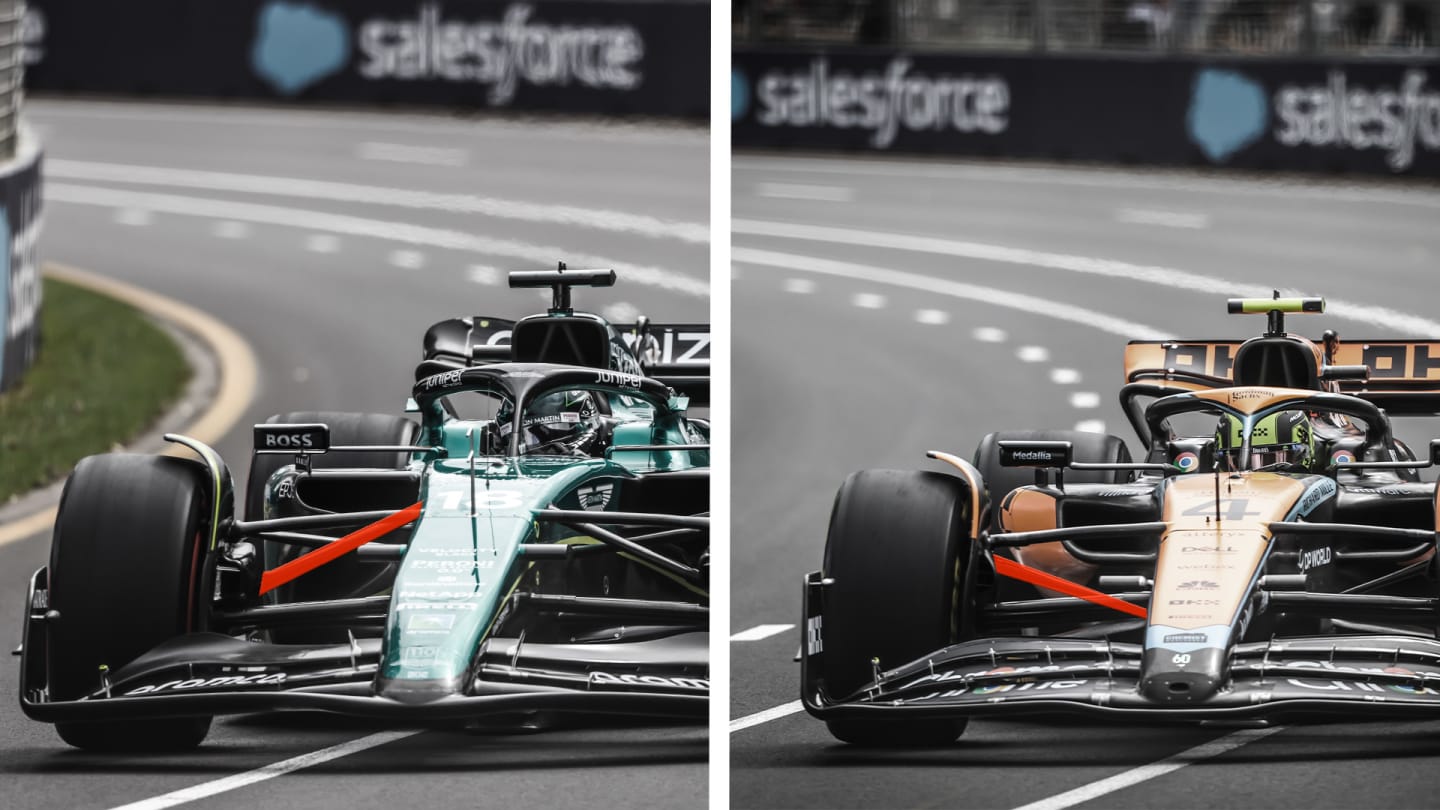
Feature
EXPLAINER: What's the difference between pull-rod and push-rod suspension?

Share

Push-rod and pull-rod suspension are terms that are used liberally in Formula 1 to describe the configuration of teams' rear and front suspension layouts. But what is pull-rod and push-rod suspension? What's the difference between the two? And is one better than the other?
Suspension, and why it's important
Formula 1 drivers – any drivers – want as much of the tyres in contact with the surface of the road as much as possible. More tyre contact means more grip, which means they can get more power down, and therefore go faster.
When there's a bump in the road, such as a kerb on an F1 circuit, the tyre runs over it and a force is applied to the tyre and the wheel.
Without suspension, the chassis of the car would essentially be attached to the wheels, so any force would be applied to the wheels and the chassis. This would not only make for a seriously uncomfortable ride, but it would mean that the car's chassis would bounce uncontrollably over any kerbs, also causing the wheels to bounce and lose grip with the road.
Suspension however allows the force of the bump and the kinetic energy to be stored by a spring, which is then compressed, absorbing the energy transferred by that bump in the road and allowing all four tyres to grip the road. That is, unless a driver takes "too much kerb", like in the image below...
)
Suspension plays an important part in the handling and behaviour of an F1 car
How does F1 suspension differ to road car suspension?
All four wheels of the F1 car are independently sprung as they use a 'double wishbone' design. All four wheels therefore move independently depending on the forces applied to each corner of the car. Some performance road cars and other racing cars also use this suspension set-up.
However, the materials – including carbon fibre – used in F1 cars are lighter and stronger, and more expensive than those used in most road cars.
F1 cars not only have to deal with immense forces applied by kerbs, debris, and whatever else they might encounter on the track, but they're also constantly being pushed down by downforce – unlike the vast majority of road cars. F1 suspension has to be strong enough to withstand that.
The elements connecting the tyre to the suspension are often visible in open-wheel cars and F1 is no different. Being exposed, those visible elements also play an important aerodynamic role in an F1 car.
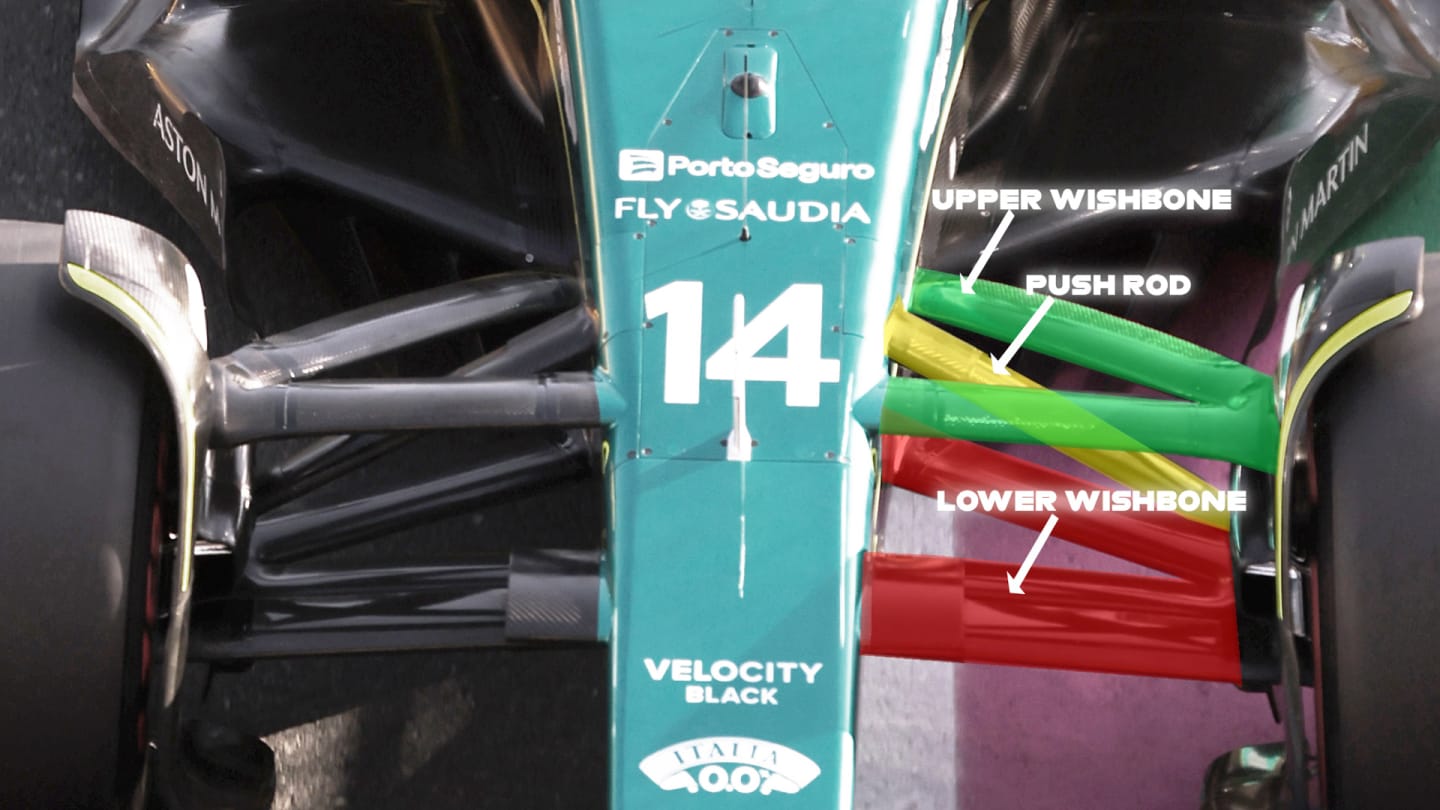
A top-down view of the front suspension on Aston Martin's AMR23, which shows the upper wishbone (green), push rod (yellow) and lower wishbone (red)
On a current F1 car, there are several points connecting the front wheels to the chassis. On the top and bottom, there are wishbones. The upper wishbone is normally shorter than the lower wishbone at the front of the car, leading to 'negative camber' – the tyres slope diagonally when they're stationary. In an F1 setting, negative camber ensures better contact between the tyre and the road and more even tyre wear.
Between the wishbones, both at the front and rear of the car there's a suspension rod, which runs from the top of the wheel uprights to the suspension spring. In an F1 car, this spring is a horizontally-mounted spring that 'twists' when force is applied to it. This is normally called a 'torsion spring'.
On a road car, those springs generally run vertically. Sometimes you can see the spring if you peer through the wheel-arch of a road car, particularly if it's sporting a double wishbone design.
Finally, as in a road car, F1 cars have 'dampers' which stop the spring from bouncing up and down uncontrollably. Dampers contain gas (or oil or fluid, in older road cars) that dissipates some of the force applied to the spring. In an F1 car, almost everything is geared towards performance rather than comfort and so teams will tune suspension and damper stiffness depending on the circuit. At Monaco, teams might go one step further and fit new steering arms to their cars to ensure a greater steering angle.
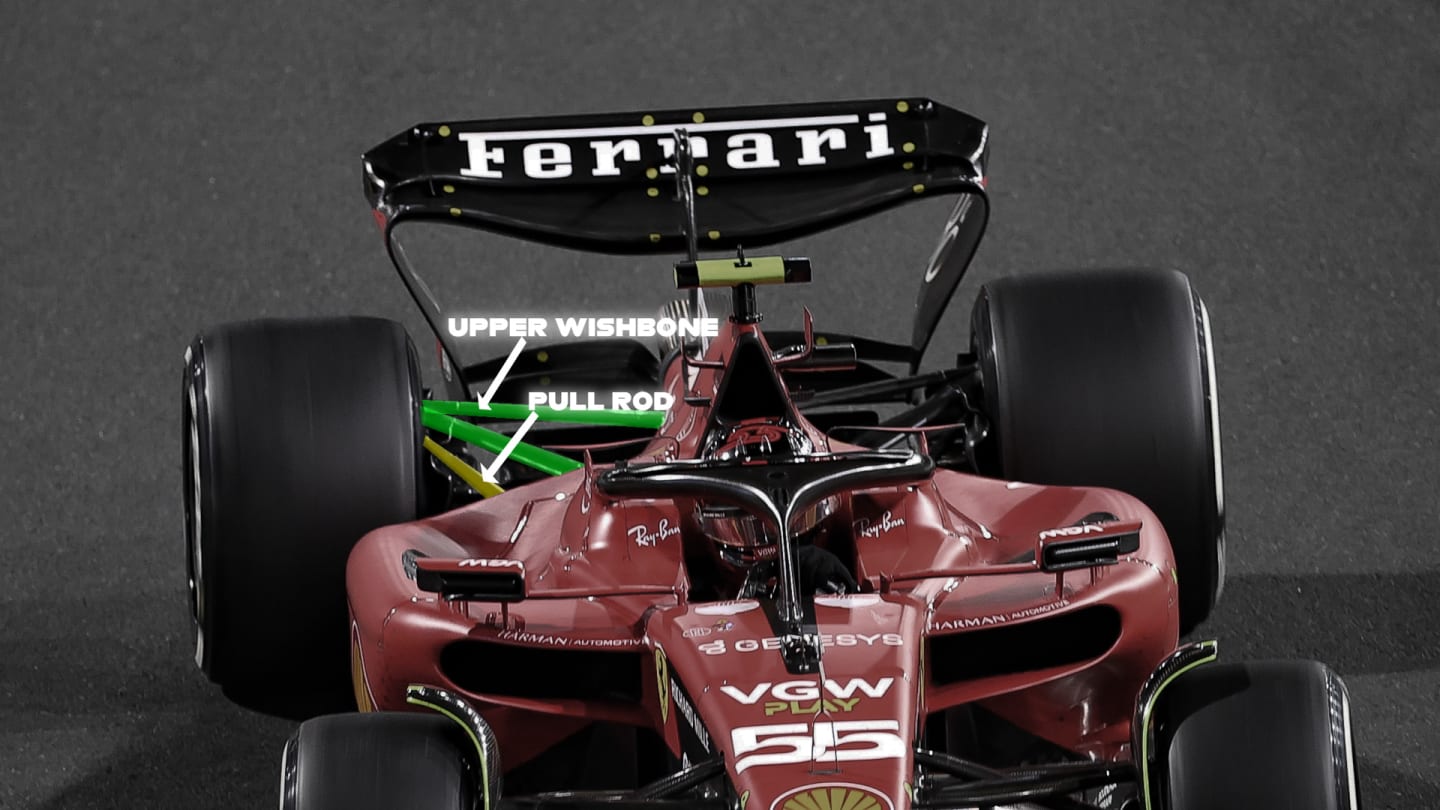
The rear suspension of the Ferrari SF-23 with upper wishbone and pull rod highlighted in green and yellow, respectively
Pull-rod vs push-rod – what's the difference?
That rod which connects the top of the wheel to the torsion spring is called the 'pull-rod' or 'push-rod'. That's because the rod can be fixed to 'pull' or 'push' that spring.
In a pull-rod configuration, the rod is mounted at a diagonal angle from a low point on the chassis, up to a higher point on the wheel assembly. When a tyre goes over a bump, the wheel pulls the torsion spring via the pull-rod, pulling the rod up and outwards from the chassis.
In a push-rod configuration, it's mounted the opposite way, so again at a diagonal angle, but higher on the chassis and lower on the wheel assembly. When the tyre goes over a bump, the wheel pushes the torsion spring via the push-rod, pushing the rod upwards and towards the chassis.
Play the short clip below for a visual demonstration of the two different systems.
TECH TALK: What's the difference between pull-rod and push-rod suspension?
Which is better?
It's not easy to make a blanket judgement on whether push-rod or pull-rod is better. Different teams run different configurations on the front and rear of their cars.
Push-rod suspension might make the springs and dampers easier to access as they're mounted higher up in the car, but other components might be harder to access as a result. Push-rod is also mounted higher on the car, increasing the car's centre of gravity. Teams will consider complexity and cost, too – but aerodynamic and performance gains will be prioritised.
As with every component on an F1 car, changing the suspension configuration will have a knock-on affect and alter the behaviour of the rest of the car in myriad ways.
For more on the pros and cons of each system, tap here to watch experts Albert Fabrega and Sam Collins explain all in F1 TV's Tech Talk show.
Teams and their suspension configurations*
| Team | Configuration |
|---|---|
| Red Bull | Front: Pull-rod; Rear: Push-rod |
| Aston Martin | Front: Push-rod; Rear: Pull-rod |
| Mercedes | Front: Push-rod; Rear: Pull-rod |
| Ferrari | Front: Push-rod; Rear: Pull-rod |
| McLaren | Front: Pull-rod; Rear: Pull-rod |
| Alpine | Front: Push-rod; Rear: Push-rod |
| Haas | Front: Push-rod; Rear: Pull-rod |
| Alfa Romeo | Front: Push-rod; Rear: Push-rod |
| AlphaTauri | Front: Push-rod; Rear: Push-rod |
| Williams | Front: Push-rod; Rear: Pull-rod |
| *As of the 2023 Australian GP |
YOU MIGHT ALSO LIKE
News Minor refinements to 2025 regulations agreed at F1 Commission meeting
News Brown predicts Piastri will ‘only get stronger’ in championship lead as he explains what that means for Norris
Feature EXCLUSIVE: ‘I’ve always been very hard on myself’ – Inside Lando Norris’ battle to deliver his best on and off the track
Podcast F1 EXPLAINS: Ask an F1 Team Principal with Alpine boss Oliver Oakes
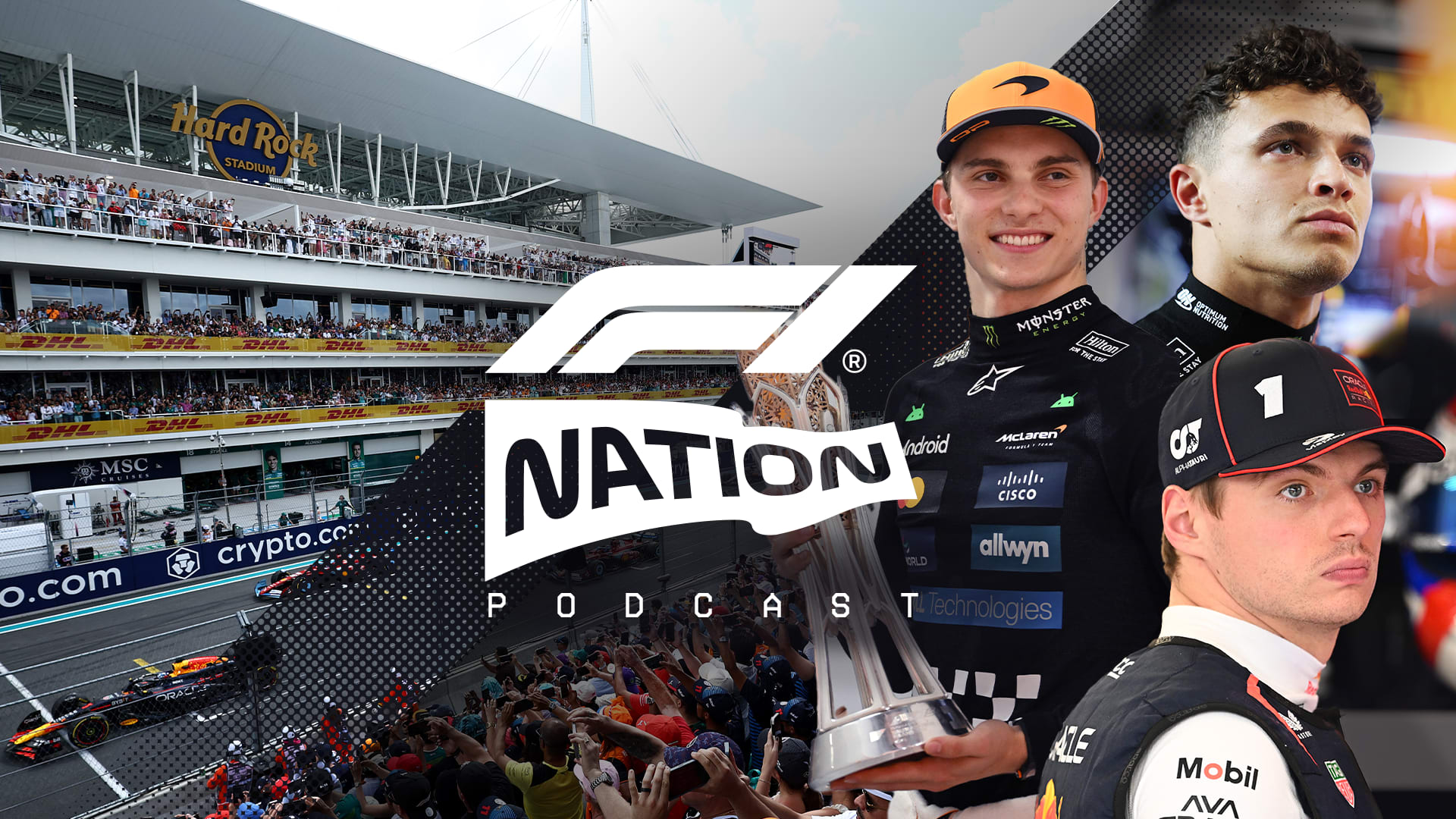
)
